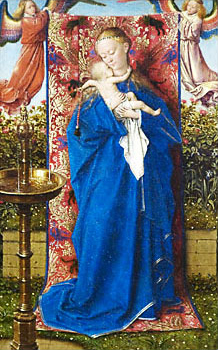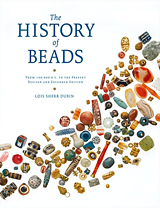
|
Different theories exist about the origin of the Christian rosary. Seventh-century graves have disclosed strings of beads twisted around the deceased's hands, a custom still followed in parts of Italy and Japan. Saint Rosalia (742–814), a relative of Emperor Charlemagne's, was reported to have been found buried with a string of little beads that ended in a cross. These beads were probably amuletic rather than counting devices.
The use of beads for saying prayers began in medieval European monasteries almost a thousand years ago. Often illiterate and unable to understand Latin, Christian laity were unable to sing or recite the psalms. Instead, they were given a set of 150 prayers to say, and they used beads to aid in counting.
Most information on European rosaries comes from medieval wills. The earliest mention of a string of beads being used to count prayers occurs in England. The eleventh-century bequest of Lady Godiva to the Monastery of Coventry involves "a circlet of gems which she had threaded on a string in order that by fingering them one by one, as she successively recited her prayers, she might not fall short of the exact number."
In the mid-sixteenth century, however, Pope Pius V decreed that the rosary had been invented by Saint Dominic (1170–1231). While there is little historical evidence supporting the claim, a series of popes have approved the tradition, and today the Dominicans are officially in charge of making rosaries. The number of beads in a typical Catholic rosary has remained constant since the middle of the sixteenth century. A chaplet of 150 small beads is divided into "decades" (groups of ten beads) by fifteen larger beads. The decade system corresponds to the ten fingers, the original method of counting. A pendant, comprised of one large and three small beads and terminating in a cross, is usually attached to the chaplet.
The 150 beads, known as the "Ave beads," correspond to the number of psalms and are used for reciting the Hail Mary prayer. A decade of Aves, counted on the small beads, is followed by a Paternoster (the Lord's Prayer), for which a larger bead is used. This is followed by the Gloria ("Glory be to God"). The fifteenth Paternoster is counted on the retaining bead, used to close the loop or chaplet. Each of the fifteen decades represents a subject, or "mystery," in the lives of Christ and Mary, which are divided into five joyful, five sorrowful, and five glorious mysteries. The division of the rosary into three sets of five decades, known as "The Three Fifties," allows prayers to be recited on the more commonly used smaller chaplets. The number three, which is a basic component of rosary numerology, has a complex history dating back to early Ireland. It is related to the trefoil of the shamrock, the national symbol of Ireland.
By the Middle Ages, men and women wore rosaries around their necks, like bandoliers across their chests, or on belts. Rosaries were often clasped in the hands or twisted around the forearm. By the fourteenth century, they were essential possessions as objects of both devotion and adornment. A chronicle of the city of Biberach, dated 1530 to 1540, relates that everyone "carried a paternoster or else was taken not to be a Christian. It was a badge of religion, and therefore of respectability."
By the thirteenth century, makers of rosaries, called "paternoster-makers," had formed guilds that specialized in beads of a particular material. There were paternosters who worked only in amber, and others who specialized in precious stones, metal, or glass. The most common rosaries were those of wood and glass, while beads of amber, agate, and particularly coral were valued for their protective attributes. In the Mediterranean region, the coral of southern Italy and the Tunisian coast was extremely popular for rosary beads. The wealthy owned beads of gold, silver, and precious stones. The elaborate quality of many rosaries became an ongoing subject of controversy. As early as 1261, the Dominicans were forbidding lay brothers to "give themselves airs by using excessively grand beads." In the middle of the fourteenth century, an Augustinian canon of Osnabrück outlawed the wearing of coral rosaries around the neck.
Royalty was not impeded by such limitations. In 1380, a listing of the jewelry of King Charles V of France records nineteen rosaries made of "rose-tinted amber, coral with pearls for markers, gold beads, jet beads with eleven gold crosses, black coral and pearls, coral alternating with beads of silver, and gold beads of Damascus work which were filled with musk." The widow of Cesare Borgia, Charlotte d'Alhret, who died in 1514, had rosaries interspersed with enameled pierced-gold beads for holding scent. It has also been recorded that Mary, Queen of Scots, was beheaded in 1587 while wearing a necklace of pomander beads.
The first descriptions of musk-filled pomanders in the shape of rosary beads stem from inventories of the fourteenth century. Pomanders, often of enameled gold and set with precious stones, were shaped as balls, hearts, or pomegranates. The fashion for wearing scented rosaries was utilitarian as well as aesthetic. In late medieval Europe, musk, cloves, and myrrh, which were commonly placed in the pomanders, were considered to offer protection against the plague.
To control the extravagances, a series of monastic and municipal laws were enacted in which monks were not permitted to wear beads around their neck. Carrying certain beads was permitted, and wearing beads in the belt denoted membership in certain religious orders.
One of the most interesting aspects of the Christian rosary is the history of its name, derived from rosarium ("rose garden"). Since classical times, the rose has been universally adored. Its form, fragrance, and color symbolize beauty, mystery, love, and perfection. Aphrodite wore rose perfume and a crown of roses, while the Muses wore garlands of roses and thyme. The ancient Romans associated roses with success and festivity: victorious warriors returning from battle were greeted with roses. In Christianity, the red rose symbolizes Christ's blood and the purity of the Virgin Mary. Originating in the concept of the Paradise Gardens of Persia (with obvious biblical roots in the Old Testament's Garden of Eden), the cloistered rose garden became an essential part of medieval architecture: a secluded, high-walled courtyard filled with fragrant roses. The rose garden was an ideal place for meditation and prayer. Collections of medieval prayers and hymns were bound into books called rosaria ("flower gardens").
By the middle of the fifteenth century, rose gardens, rose garlands, and rosaries were associated with the Virgin Mary and the Christ Child in paintings and in the illustrations of rosary books (above). Religious paintings of the period are often set in rose gardens, under rose arbors, or near a rosebush. Angels and the Christ Child are seen wearing or holding rosaries.
It is unclear at what point the word meaning "a garden of roses" was transformed into "a string of beads used to count prayers." Nonetheless, the spiritual identity of roses was extended to beads, which came to symbolize a permanent garden of prayer called the rosary.
Roman Catholic Rosaries » Prayer Beads » The History of Beads: From 100,000 B.C. to the Present
Lois Sherr Dubin (2009) Abrams Publishers, Inc.



